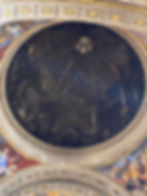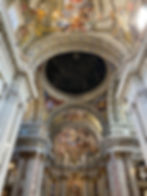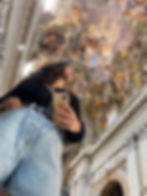Andrea Pozzo's Fake Dome in The Church of Saint Ignatius Loyola: Can Art Truly Deceive The Eye?
- Tatyana
- Aug 13, 2020
- 2 min read
Updated: Dec 22, 2022
The Church of Saint Ignatius Loyola in Rome (Chiesa di Sant' Ignazio di Loyola) is home to some of the most astounding illusionistic frescoes ever created. They were painted by the Italian Baroque artist Andrea Pozzo between 1685 and 1694.

The Church itself is named after the founder of the Jesuit order, Ignatius Loyola, who was later canonized as a saint. His tomb is located inside the church.
Who were the Jesuits? The Jesuits were an apostolic religious community also known as the Society of Jesus. They were grounded in their love for Christ and their mission was to help others seek God in all aspects of their lives.
The Church of Saint Ignatius Loyola was originally meant to have a magnificent dome, but the Jesuits unfortunately ran out of money in 1642, and the plans thus had to be scrapped.

The dome visible from the interior of the church is actually an optical illusion. It was painted on a nearly flat ceiling by the Jesuit painter Andrea Pozzo to hide the fact that a lack of money had hindered the building of a real dome.
Pozzo’s trompe l’oeil work is extremely compelling in its deceiving nature. Pozzo has not only created the illusion of depth, he has also created the semblance of an outer world whose presence can be felt from inside of the church. Notice, for example, his delicate rendering of rays of light that come through one of the fake openings to the left of the painted dome.

Pozzo also painted another illusion for the barrel-vault ceiling of the church's nave. The huge painting that covers the entirety of the nave ceiling depicts the life and work of Saint Ignatius Loyola, and the apostolic activity of the Society of Jesus around the world. Pozzo’s flawless rendering of perspective lifts and expands the building skyward; the figures and animals appear to recede upwards into the heavens.
Pozzo was so skilled at this technique of painting, known as Quadratura, that he wrote a book on the subject for other Baroque artists to make use of entitled: Perspectiva Pcitorum et Architectorum.
PRO TIP: The best way to observe the illusionistic dome is by looking at it while standing on the first marble circle you come across on the nave floor.
FUN FACT: The Church’s nave is equipped with a full-length tilted mirror for visitors to get a closer look at the ceiling frescoes without craning their necks. It also makes for great selfies! (Hence my photo below!)
To learn more about Baroque art, check out my course entitled The Art of the Baroque.









